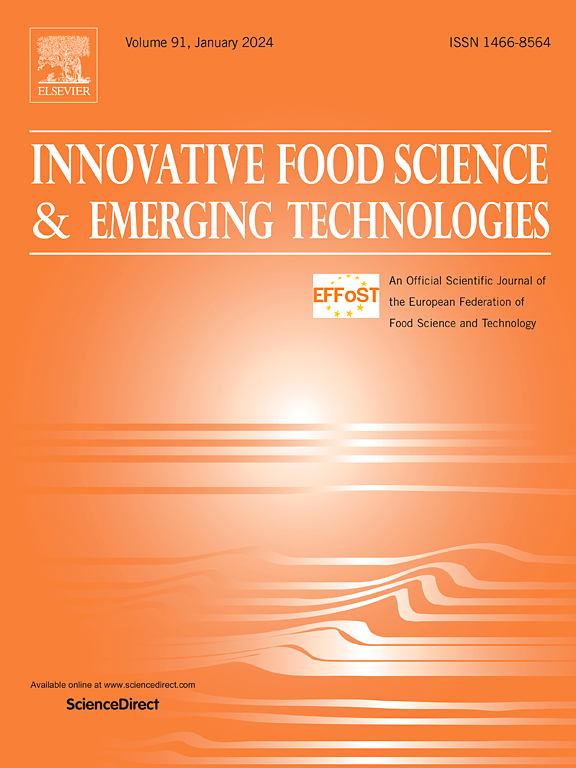冷血浆辅助转谷氨酰胺酶交联:对大豆蛋白组分结构和成膜特性的影响
IF 6.3
1区 农林科学
Q1 FOOD SCIENCE & TECHNOLOGY
Innovative Food Science & Emerging Technologies
Pub Date : 2025-02-07
DOI:10.1016/j.ifset.2025.103946
引用次数: 0
摘要
为了研究冷等离子体(CP)和谷氨酰胺转胺酶(TGase)对大豆蛋白组分溶液和成膜的结构和理化性质的影响,在成膜溶液制备的不同阶段进行了动态监测。研究重点包括表面疏水性、粒径、本征荧光和巯基含量等关键参数。结果表明,不同时间(1、2、3、4和5 min)的CP处理和TGase交联显著影响了蛋白质的界面性质和分子间相互作用。随着CP处理时间的延长,膜的交联度和蛋白质相互作用显著增强。此外,蛋白质二级结构顺序、水屏障和力学性能的改善表明了CP辅助TGase交联蛋白质的可行性和有效性,特别是CP处理3 min的膜样品具有更高的机械强度(从7.71 MPa到9.00 MPa)和更低的水蒸气渗透性(从4.77 × 10−10 g Pa−1s−1m−1到3.97 × 10−10 g Pa−1s−1m−1)(p <;0.05)。本研究为CP技术在环保包装薄膜中的应用提供了新的见解。本文章由计算机程序翻译,如有差异,请以英文原文为准。
Cold plasma-assisted transglutaminase cross-linking: Effects on the structure and film-forming properties of soybean protein fractions
To investigate the impact of cold plasma (CP) and transglutaminase (TGase) on the structural and physicochemical properties of soybean protein fraction solutions and films, dynamic monitoring was performed at different stages during the preparation of film-forming solution. The study focused on key parameters including surface hydrophobicity, particle size, intrinsic fluorescence, and sulfhydryl content. The results showed that both different durations (1, 2, 3, 4 and 5 min) of CP treatment and TGase cross-linking significantly affected the interfacial properties and intermolecular interactions of the proteins. With the increase in CP treatment time, the cross-linking degree and protein interaction of the films were significantly enhanced. Additionally, the improved order of protein secondary structure, water barrier and mechanical properties indicated the feasibility and effectiveness of CP-assisted TGase cross-linking of proteins, especially the film sample treated with CP for 3 min showed higher mechanical strength (from 7.71 MPa to 9.00 MPa) and lower water vapor permeability (from 4.77 × 10−10 g Pa−1s−1m−1 to 3.97 × 10−10 g Pa−1s−1m−1) (p < 0.05). This research provides new insights into the application of CP technology in environmentally friendly packaging films.
求助全文
通过发布文献求助,成功后即可免费获取论文全文。
去求助
来源期刊
CiteScore
12.00
自引率
6.10%
发文量
259
审稿时长
25 days
期刊介绍:
Innovative Food Science and Emerging Technologies (IFSET) aims to provide the highest quality original contributions and few, mainly upon invitation, reviews on and highly innovative developments in food science and emerging food process technologies. The significance of the results either for the science community or for industrial R&D groups must be specified. Papers submitted must be of highest scientific quality and only those advancing current scientific knowledge and understanding or with technical relevance will be considered.

 求助内容:
求助内容: 应助结果提醒方式:
应助结果提醒方式:


